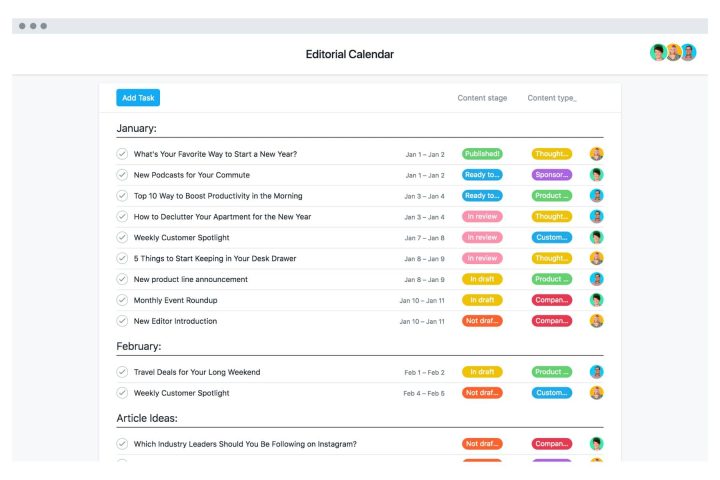How content helps you grow your business
Did you know that businesses that actively blog get 67% more leads than those who don’t? And that almost half of all buyers consume 3 tot 5 pieces of content before talking to your sales team? At Upperscore, we’re big on content, and it’s precisely because of statistics like these.
It has been a cliché for some time: content is king. And if you ask us, content marketing is more important than ever. If you have not been using any content in your marketing strategy, you have been seriously missing out, and it’s time to fix that. In this article, we’ll share our ideas on how content marketing helps you grow your business.
What is content marketing
Perhaps Content Marketing Institute says it best:
"Content marketing is a strategic marketing approach focused on creating and distributing valuable, relevant, and consistent content to attract and retain a clearly defined audience — and, ultimately, to drive profitable customer action."
If attracting the right people is the goal, this immediately has a number of implications. For starters, you’ll want to be present on the right channels: being found in search engines, posting on social media and so on. If you want customer action, at some point your content will need to convince people to take action, so you’ll need content in every stage of the buyer journey:
- Awareness stage: Your target audience is looking for information about the problem they are trying to solve.
- Consideration stage: Your target audience is figuring out different ways to solve their problem.
- Decision stage: They are looking at specific solutions for their problem.
Write for your target audience
This one seems very logical, but so many companies still get this completely wrong. They don’t write for their intended prospects or customers, they write for themselves. Far too often, we hear people react to their own content as in ‘I like it this way’ or ‘this makes sense to me’.
But the thing is: it doesn’t need to make sense to you at all. It needs to make sense to your visitors, prospects and customers. They look at your products and services from a completely different angle. They don’t know all the ins and outs, they have no clue about how your products are made, or who makes them. All they know is they have a problem they want to solve, and they are looking for information about that. They’re not interested in hearing you brag about yourself and your product.
So don’t be that company that writes a blogpost or a brochure with a long list of features your product has. Instead, try to write how it solves problems that people in your target industry have. Write about the problem itself, and how it impacts people’s lives. Write about how much better life would be if that problem could be fixed, and how your product helps them solve the problem.
Use a content calendar
Just writing a bunch of content pieces and randomly throwing them online is not going to get you very far. You need a decent plan. A content calendar can help you plan your content marketing efforts. There are different elements here to consider:
- you’ll want to plan when to post what content piece
- some content is going to take longer to create
- you might need to bring other people into your content marketing team
- you want to get a good idea about what your content marketing is going to cost
All of these have a significant impact on planning and budget, and therefor are necessary to manage in a content calendar.
Another good reason to keep a content calendar is because it will also help you map out different types of content you need for different stages in the buyer journey, or for different buyer persona’s. Ideally, you create content for all stages, so you can guide your buyer persona through the whole buyer journey.

What you see here, is an example of a content calendar in Asana. This has been our software of choice, but you could also use monday.com, or just a Google sheet if you want something very basic and easy to use.
Educate people
People are not coming to your website just for their pleasure. They are looking for information that will help them solve something. So if you want them to come to your website and keep coming back, or take a desired action, you’ll need to offer them something.
Creating awareness has a lot to do with educating people. In the beginning of the buyer journey, there is still a lot that your visitors don’t know. By educating them, you do 2 things:
- you help them along their buyer journey
- you build credibility with your audience
Do your keyword research
With ads and privacy constantly changing, your SEO strategy is more important than ever. To get the most out of that, you need to do your keyword research.
The problem with keywords is that everybody wants to be on the first page of the SERP’s (Search Engine Result Pages). If all of us want to rank for the exact same keyword, then obviously only a very small group of companies will get the desired result. But the truth is: we don’t all need to focus on that one keyword.
Instead, you should perform a keyword research and look for a variety of relevant keywords for you business that may have a lower search volume, but also less competition. You do that by first brainstorming some content ideas. After the brainstorm, you should input your content ideas into a keyword tool (for example Google Keyword Planner) and combine everything you find into an excel sheet. After that, it’s time to analyze your findings and filter out those keywords you think are best to focus on.
Things to focus on:
- Trend: Is there a rise or decline for a specific keyword, or is it searched for quite consistently?
- Keyword volume: what is the average search volume for specific keywords?
- Competition: how much competition is there, or in other words: how likely is it that you will rank for a keyword?
This can be a daunting task if you are not familiar with it, but don’t let the amount of data on your screen scare you. Try to dive into the numbers and understand what they mean. Pretty soon, you’ll start to get some insights. The important thing in the beginning is to find a good place to start
Promote your content on different channels
Many businesses seem to think that blog articles or product pages are just magically going to get read by the right people, without putting any effort into promotion. If this is you, we have some bad news: it takes some promotion on your part to get your message in front of the right people.
SEO and organic traffic are something to definitely focus on, but it takes a lot more time than you think to get to the organic search results you want. So why not help fate a little bit?
Your target audience is guaranteed to use some form of social media. For some businesses, LinkedIn may be the go to platform, for others it may be Facebook, Instagram or TikTok. So you should take a closer look at your buyer persona’s and find out what channels they use. And make sure to use some video as well: it’s a must these days and some people will just not respond well to your written content.
Another way of promoting your content is by sending personalized and well segmented emails to your database. Just because they are already a lead doesn’t mean you can stop doing your marketing: you still need to convince them. You could also use cold email outreach to get your message in front of new leads. But be careful to make it relevant and personal for them, otherwise your message just screams ‘sales’ and you are done.
Analyze your data
As you start rolling out your content marketing, you’ll notice that not everything you do will have the desired result. Especially in the beginning, it’s hard. And it’s normal. As you publish more and more content, you really should look at the results. Again, a daunting taks for many, and it involves data you may not be familiar with, but it’s very valuable information.
In your analytics tools, try to get an idea of the types of content that get the most attention. If you use different types of content, you can also look at what types perform best. You can also do this on your social media. And it would be even better if you got all data from all your different channels into one single platform.
With the insights you get from your analysis, you can decide on what content to create next. It should at the very least help you adjust your marketing strategy, refine topics and help you fuel your content calendar with new ideas. We can’t stress this enough: analyzing your results is a key factor in. your marketing success!
Content marketing is not an easy thing to do, but if you master everything we discussed above, you are well on your way to have a serious impact on your marketing and sales results. Along the way, you’ll learn a lot of new things you can apply for your business growth. Keep an eye out for more about the subject here on our website, or feel free to book a free meeting with us if you have any specific questions.
Develop an effective content marketing strategy
Create an effective content plan that convinces attracts the right visitors to your brand and converts them into great leads!






